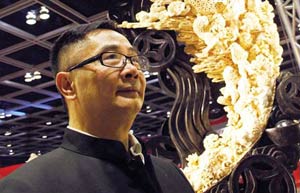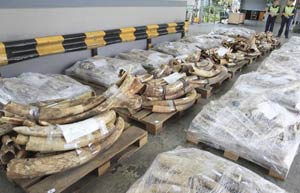A wooly mammoth hides underneath the world's longest outdoor escalator, amid the flashing lights, art galleries and cocktail bars of Hollywood Road in Hong Kong's Central district.
The shaggy-haired mammoth with curling tusks is only an illustration. A promotional banner shows the prehistoric creature outside a small shop, Star Company, which sells mammoth ivory products.
Japanese-style netsuke, or miniature sculptures, fill the storefront display, enticing curious pedestrians into the upstairs showroom. Carvings occupy every corner of the store. There are scrimshawed netsuke, beaded jewelry and tusks chiseled with Chinese themes. There are also hippo teeth, walrus tusks and stone carvings packed into wall-to-wall display cases. But the vast majority of merchandise comprises mammoth.
At least 12 distributors sell mammoth ivory products in Hong Kong, according to the Hong Kong Trade Development Council website. Roughly half a dozen retail vendors sell mammoth ivory products among western Hollywood Road's antique shops.
Star Company is a family business: William Lau owns the shop, and his sister often helps with daily operations. They also own a carving factory in Guangdong province. Their father started the company in 1964 as a jade carving outfit, and gradually they began working with ivory.
But in 1989, the Convention on International Trade in Endangered Species effectively banned the international trade of elephant ivory. Star Company's stockpile of elephant ivory shrank and operations downsized, so they transitioned into mammoth ivory in the mid-1990s.
Another person to spearhead Chinese trade in mammoth ivory is Hong Kong businessman Daniel Chan. The Fuzhou native moved to Hong Kong and worked his way up from accountant to factory boss by 1972. Chan operates Lise Carving & Jewellery, which has carving operations in Hong Kong and the Chinese mainland.
"I began buying mammoth tusks from suppliers in Alaska and Canada in 1983. That was a very busy time for (elephant) ivory," says Chan. "In 1983, nobody wanted to use the prehistoric material; only me. I bought and kept it."
After the fall of the Soviet Union, mammoth ivory from Siberia - where carcasses of the extinct animal have been found in recent years - became more easily available.
Most of the world's undiscovered mammoth remnants are buried in the Russian permafrost. Indigenous tusk hunters, reindeer herders and speculators harvest the tusks in the summer when the ground thaws, and Russian dealers aggregate the tusks. Then, tusks must pass inspections in Moscow to confirm specimens are not important scientific or cultural relics.
Mammoth ivory as a commodity has struggled to gain traction over the popularity of elephant ivory across China, though the perception is changing.
 |
 |
| Mammoth task to achieve |
|
